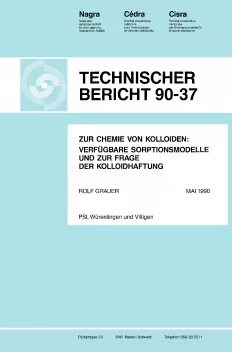
Technischer Bericht NTB 90-37
Zur Chemie von KolloidenVerfügbare Sorptionsmodelle und zur Frage der Kolloidhaftung
A safety analysis of a radioactive waste repository should consider the possibility of nuclide transport by colloids. This would involve describing the sorption properties of the colloids and their transport in porous and fissured media. This report deals with a few selected aspects of the chemistry of this complex subject.
Because the mechanisms of ion adsorption onto surfaces are material-specific, increased attention should be paid to identifying the material constitution of aquatic colloids. Suitable models already exist for describing reversible adsorption; these models describe sorption using mass action equations. The surface coordination model, developed for hydrous oxide surfaces, allows a uniform approach to be adopted for different classes of materials. This model is also predictive and has been applied successfully to natural systems.
From the point of view of nuclide transport by colloids, irreversible sorption represents the most unfavorable situation. There is virtually no information available on the extent of reversibility and on the desorption kinetics of important nuclide/colloid combinations. Experimental investigations are therefore necessary in this respect.
The only question considered in connection with colloid transport and its modelling is that of colloid sticking. Natural colloids, and the surfaces of the rock on which they may be collected, generally have negative surface charges so that colloid sticking will be difficult. The DLVO theory contains an approach for calculating the sticking factor from the surface potentials of the solid phases and the ionic strength of the water. However, it has been shown that this theory is inapplicable because of inherent shortcomings which lead to completely unrealistic predictions. The sticking probability of colloids should therefore be determined experimentally for systems which correspond as closely as possible to reality.
